While there are many countries where horse meat is available and consumed occasionally (sometimes unbeknownst to the consumers), Kazakhstan is one of the few places where it’s one of the major meats in the butcher’s display. Its use goes beyond the traditional kazy and beshbarmak, and at some restaurants in the larger cities, you can enjoy a thick, juicy horse steak.
Which I did, during my trip to Kazakhstan last summer! Fast forward a few months and, happening upon horse medallions at a Quebec supermarket, I started forming this idea for a very urban and cosmopolitan recipe of Kazakh inspiration, based on my early impressions of the country after a few days spent in Almaty. The local cuisine may not be all that varied, but I came up with a juxtaposition of elements with various cultural influences:
- First the horse steak, of course. I don’t think that Kazakhs in the countryside eat a lot of medium-rare steaks. The concept of rare steak is a modern Western import; in fact eating meat cooked to any doneness other than “well” remains a rarity. Yet rare / medium-rare is a great way to eat the most tender horse cuts. Horse meat is pretty similar to beef, but leaner, slightly sweet, and a tiny bit gamier. A good substitute would be bison, which is more readily available (get your bison / buffalo steak here), but if you’re dead set on the equine experience, you’ll have to cross the US border to the North and, uh, do your cooking in Quebec, where it’s sold in several supermarkets (you can find some addresses here).
- Next, khychin. This very thin flatbread is the very first food that I tried in Kazakhstan, as an appetizer at dinner upon my arrival. As it turns out, it doesn’t even originate from Kazakhstan, this is a Karachay dish. It’s typically filled with cheese and potato, and feels like rustic mountain food, which kind of makes sense since Karachay-Cherkessia consists mostly of mountainous terrain. It’s also not out of place in Almaty, which is bordered to the south by the Tian Shan mountains. If you’re into instructional photos, check out the step-by-step recipe here, or the how-to video here. Recipes from different regions use varying amounts of oil to cook the flatbread, from none at all to a thin layer for shallow frying.
- And finally, morkovka po-korejski (sometimes just called morkovka in Central Asia), a simple grated carrot salad hailing from Koryo-saram cuisine (more on this another day). My recipe is inspired by this blog post, but my carrots are definitely grated more thinly than tradition dictates. And since I’ve never been a great fan of grated carrots in the first place, I also decided to throw half of them in a blender to make a purée.
- As for the scallions that I’m pairing with the steak… They taste great, but I’m not sure how they ended up here. Call it the Food Perestroika influence.
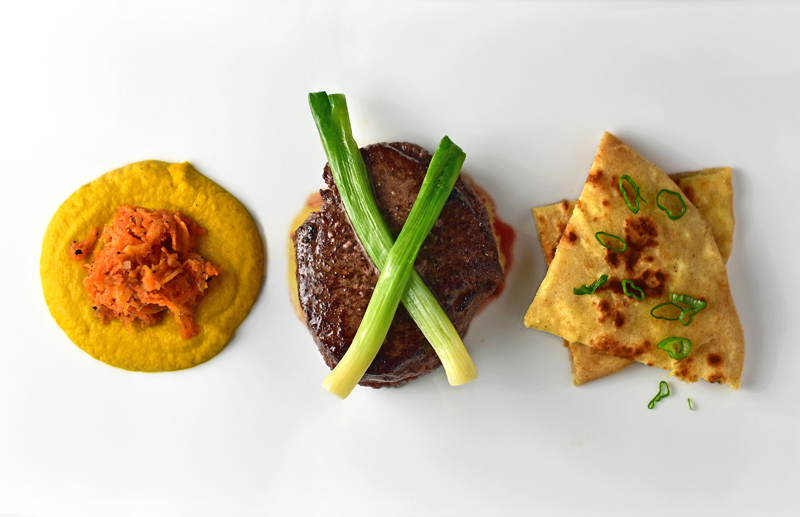
Morkovka
Yields 4 servings
25 g peeled onion, cut into a brunoise
25 g canola oil
4 g peeled garlic cloves, minced
2.7 g ground coriander seeds
1 g Urfa pepper
11 g red wine vinegar
5.5 g superfine sugar
1.5 g salt
150 g peeled carrots, thinly grated
- In a small saucepan over medium heat, sauté the onion in the oil until golden brown. Add the garlic, and cook for a minute. Stir in the coriander and Urfa pepper, and cook for another 30 seconds. Let cool.
- In a small container, combine the vinegar, sugar, and salt.
- In a mixing bowl, toss the carrots with the vinegar mixture. Add the onion mixture with all the oil from the pan, and combine. Cover with plastic wrap, and refrigerate for at least 4 hours.
Morkovka purée
Yields 4 servings
45 g butter
95 g water
115 g peeled carrots, small dice
1/2 of morkovka (about 100 g)
salt
- Heat half of the butter and half of the water in a small saucepan over low heat. Add the carrots, cover, and cook until tender. Add the morkovka, and cook for another minute.
- Transfer the mixture to a blender. Add the rest of the butter and water, then process until smooth. Rectify the seasoning with salt, and pass the purée through a chinois. Reserve.
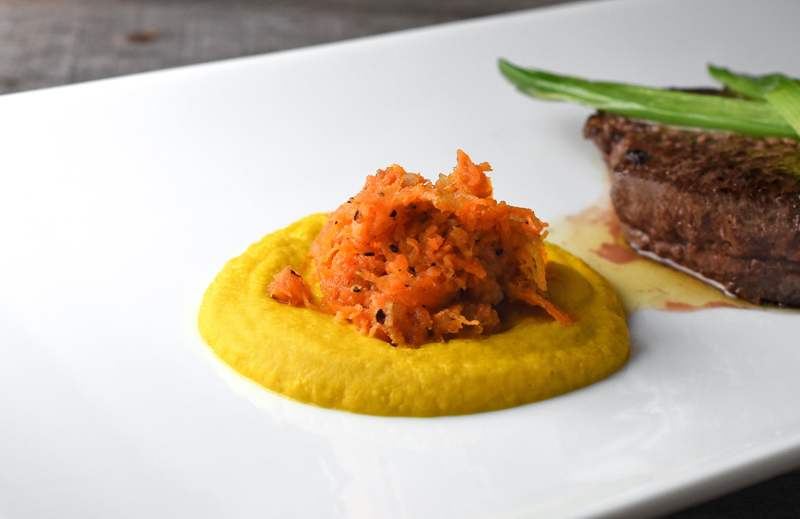
Khychin
Yields 8 servings (4 flatbreads)
180 g AP flour, sifted
110 g milk
2 g salt
130 g potatoes
130 g brynza or Bulgarian feta
salt
about 30 g butter
- In the bowl of an electric mixer fit with the paddle attachment, mix the flour, milk, and salt on medium speed for 1 minute. Cover, and let rest for 30 minutes.
- Cook the potatoes in unsalted boiling water until tender. Drain, rice, and transfer to a bowl. Crumble the brynza into the bowl, and mix. Add salt if needed (careful, the cheese might be salty enough).
- Shape the cheese and potato mixture into 4 balls the size of an egg, about 60 g each.
- Divide the dough into 4 pieces, about 70 g each.
- Roll each piece of dough into a 16-17 cm diameter disc. Place a ball of cheese and potato mixture in the middle, and fold the edges of the dough over it, closing like a purse. Pinch and cut the extra dough at the top. Try to bring all the folds to the top so you cut off as much dough as possible, since the bread should be really thin. (Technique not clear? Check out the pictures from my lángos burger recipe.)
- Flatten the dough back to a disc with your hand, then gently roll to a 14-15 cm diameter disc. Don’t rush, or the mixture might start leaking.
- Heat a non-stick pan over medium heat. Melt a generous nugget of butter, and add one khychin. Cook until golden brown on both sides. Transfer to a plate, and add another nugget of butter on top. Repeat with the remaining khychins.
- Cut each khychin into quarters, and reserve.
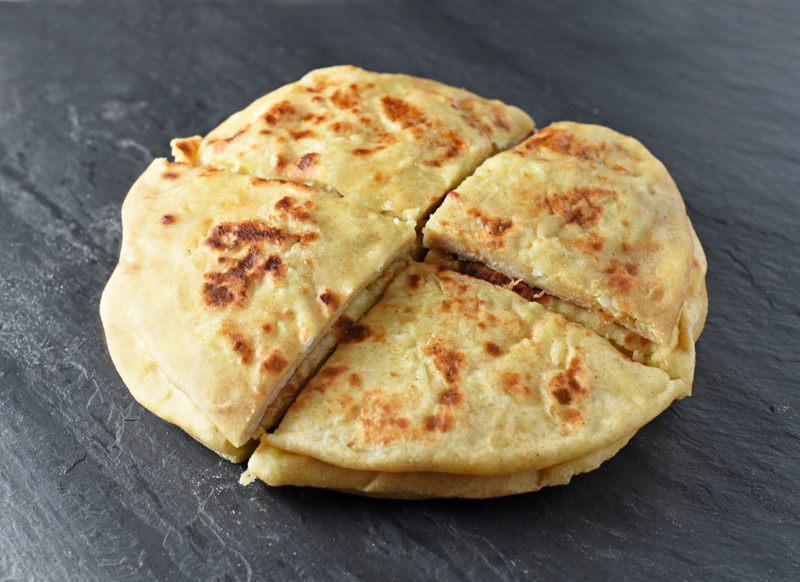
Scallions a l’étuvée
Yields 4 servings
16 g butter
16 g water
8 scallions, trimmed to about 7cm, peeled
salt
black pepper, ground
- Heat the butter and water in a small saucepan over low heat. Add the scallions, season with salt and pepper, and cover. Cook until tender.
- Remove from the heat, and reserve.
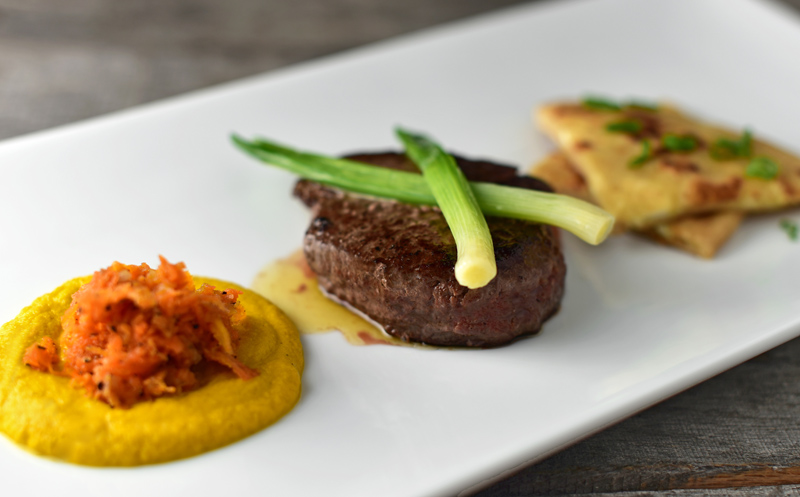
Assembly
Yields 4 servings
4 horse meat medallions, about 130 g each
salt
canola oil
black pepper, ground
30 g butter
morkovka purée
scallions a l’étuvée
morkovka
2 khychins, quartered (8 slices)
scallion greens, thinly sliced
- Season the horse medallions with salt. Heat the canola oil in a pan over high heat, and sauté the meat until brown on both sides.
- Transfer to an ovenproof dish. Season with black pepper, top with slices of butter, and cook in a 200 F oven to the desired doneness (I recommend rare).
- Sauté the medallions one more time with canola oil in a hot pan, and let rest for a couple minutes.
- Reheat the morkovka purée and scallions a l’étuvée.
- On the left side of a rectangular plate, pour a couple spoonfuls of morkovka purée, and top with morkovka. In the center of the plate, place a horse medallion, spoon some of the melted butter over it, and top with two scallions. On the right side of the plate, arrange two slices of khychin, and sprinkle with scallion greens. Repeat with three more plates. Serve!
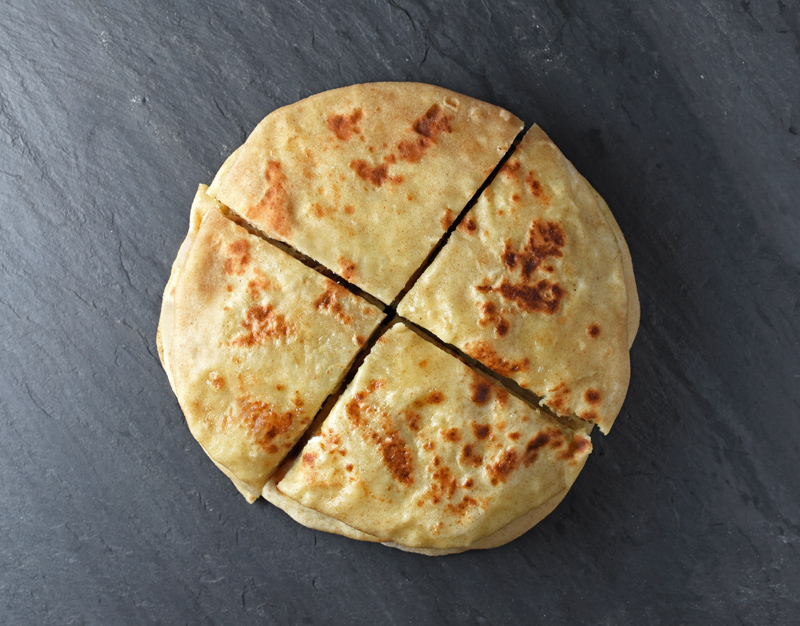

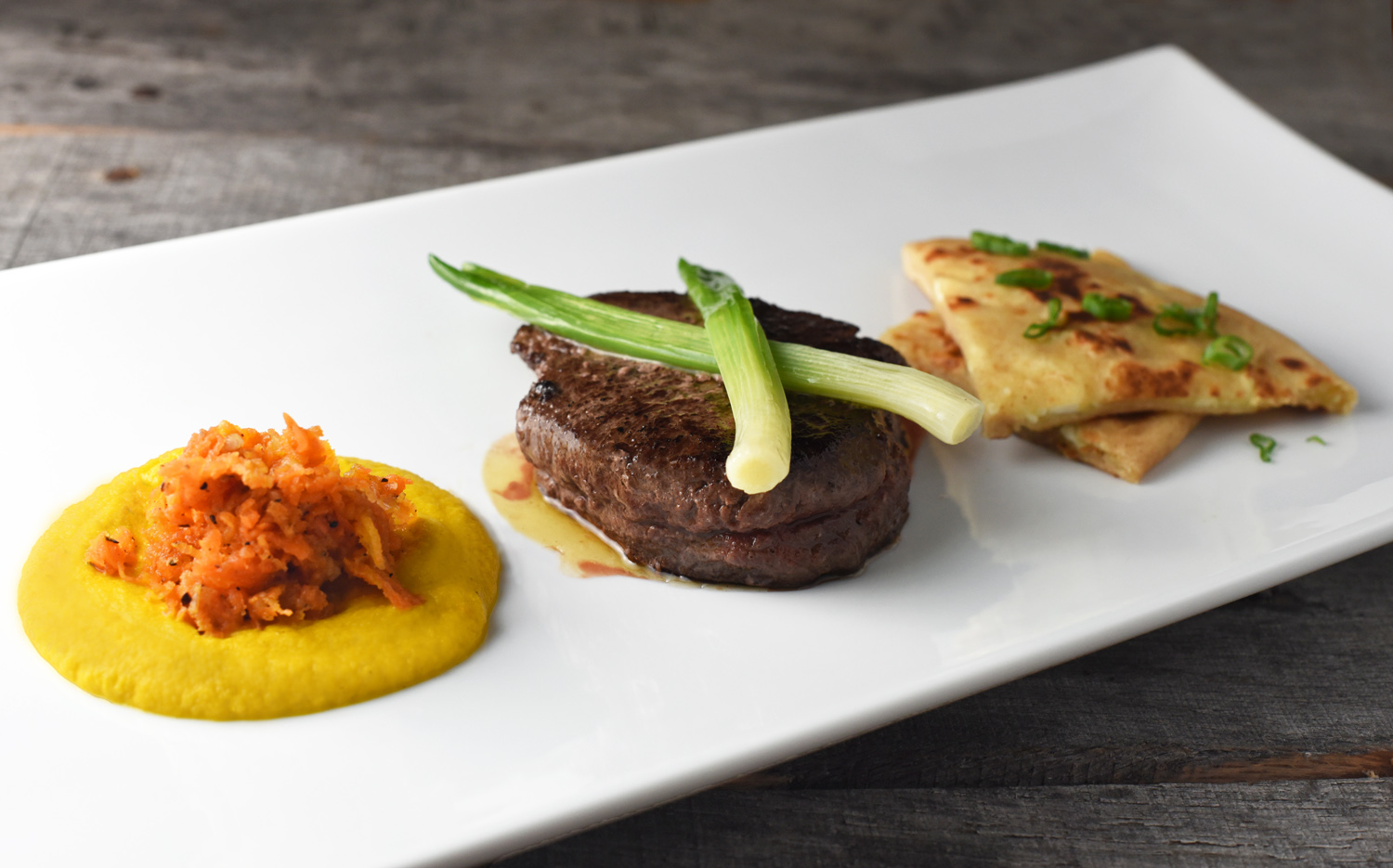
2 comments
Yo, Kychiny aren’t Kazakh, they’re Karachay. Morkovka just means carrot, if you want to specify the Korean-style salad, you have to call it morkov po-koreisky.
Yo, thanks for the fact check! I hadn’t realized that kychiny were originally from Karachay, I’m going to correct this. You’re right of course that morkovka just means carrot, but this is a shortcut I’ve seen on some menus — again, I’ll clarify in the post.